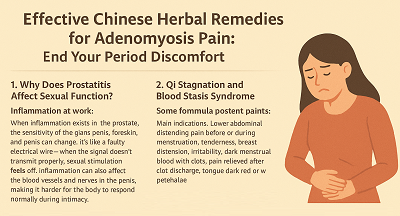Effective Chinese Herbal Remedies for Adenomyosis Pain: End Your Period Discomfort
For women suffering from adenomyosis, finding effective relief methods is an urgent concern. Traditional Chinese Medicine (TCM) has its unique advantages in treating this condition. By following the principle of syndrome differentiation and treatment, TCM targets different constitutions and symptoms using corresponding herbal formulas, aiming to regulate the root causes and alleviate pain. The following are commonly used Chinese herbal formulas for treating adenomyosis-related dysmenorrhea. Let's take a closer look.

Fuyan Pill
Main indications: Fuyan Pill is suitable for adenomyosis accompanied by chronic gynecological inflammation, commonly presenting with lower abdominal pain, abnormal vaginal discharge, and irregular menstruation.
Treatment principle: Clear heat and detoxify, invigorate blood and resolve stasis, strengthen the spleen and eliminate dampness.
Formula characteristics: A proprietary patent herbal preparation composed of more than ten herbs.
Common herbs:
- Clear heat and detoxify: Scutellaria (Huang Qin), Gardenia (Zhi Zi) — remove internal heat and toxins, reduce inflammation.
- Invigorate blood and resolve stasis: Angelica (Dang Gui), Peach kernel (Tao Ren), Safflower (Hong Hua) — improve blood circulation and relieve dysmenorrhea.
- Strengthen spleen and remove dampness: Poria (Fu Ling), Atractylodes (Bai Zhu), Chinese yam (Shan Yao), Atractylodes rhizome (Cang Zhu), Talc (Hua Shi) — enhance spleen function and expel dampness.
- Harmonize herbs: Bupleurum (Chai Hu) to soothe liver and regulate qi, Licorice (Gan Cao) to harmonize the formula.
Precautions: Contains blood-invigorating herbs, so pregnant women or those with gastric ulcers, gastrointestinal bleeding, or hemorrhoidal bleeding should use with caution. Due to individual differences and the formula being proprietary, it must be used under the guidance of a professional TCM practitioner; do not self-prescribe.
Qi Stagnation and Blood Stasis Syndrome
This is a very common pattern, with dysmenorrhea often closely related to emotional factors.
Main indications: Lower abdominal distending pain before or during menstruation, tenderness, breast distension, irritability, dark menstrual blood with clots, pain relieved after clot discharge, tongue dark red or with petechiae.
Treatment principle: Soothe liver qi, regulate qi, invigorate blood, and relieve pain.
Classic formula: Ge Xia Zhu Yu Tang (Corrections of Medical Errors)
Common herbs:
- Core group: Peach kernel (Tao Ren), Safflower (Hong Hua), Angelica (Dang Gui), Chuanxiong (Chuan Xiong), Red peony root (Chi Shao), Moutan bark (Dan Pi) — invigorate blood and resolve stasis.
- Qi-regulating group: Tabanus (Wu Ling Zhi), Corydalis (Yuan Hu), Lindera (Wu Yao), Cyperus (Xiang Fu), Bitter orange (Zhi Ke) — regulate qi and relieve pain.
- Assistants: Licorice (Gan Cao) — harmonize the herbs.
Cold-Congealed Blood Stasis Syndrome
This type of dysmenorrhea is often caused by exposure to cold or a yang-deficient constitution, resulting in blood stasis.
Main indications: Lower abdominal cold pain before or during menstruation, relieved by warmth, scanty and dark menstrual blood with clots, aversion to cold, cold limbs, pale complexion, dark tongue with white coating.
Treatment principle: Warm the meridians, disperse cold, invigorate blood, and relieve pain.
Classic formula: Shao Fu Zhu Yu Tang (Corrections of Medical Errors)
Common herbs:
- Warm meridians: Fennel (Xiao Hui Xiang), Dried ginger (Gan Jiang), Cinnamon (Rou Gui) — warm and unblock meridians, relieve cold pain.
- Invigorate blood: Angelica (Dang Gui), Chuanxiong (Chuan Xiong), Red peony root (Chi Shao) — nourish and activate blood.
- Resolve stasis and relieve pain: Cattail pollen (Pu Huang), Tabanus (Wu Ling Zhi), Corydalis (Yuan Hu), Myrrh (Mo Yao) — specifically target lower abdominal blood stasis for strong pain relief.
Phlegm and Blood Stasis Congealing Syndrome
This pattern involves both blood stasis and phlegm-damp accumulation, often forming palpable masses or nodules.
Main indications: Lower abdominal pain with a fixed location, worsens during menstruation, generally overweight body type, often accompanied by chest fullness, epigastric distention, thick or sticky vaginal discharge, tongue swollen and purple with greasy coating.
Treatment principle: Transform phlegm and remove dampness, invigorate blood, and resolve masses.
Common formulas: Can choose Cang Fu Dao Tan Wan combined with Gui Zhi Fu Ling Wan, adjusted as needed.
Common herbs:
- Transform phlegm-damp: Pinellia (Ban Xia), Tangerine peel (Chen Pi), Poria (Fu Ling), Atractylodes (Cang Zhu), Bile arisaema (Dan Nan Xing).
- Invigorate blood and resolve masses: Peach kernel (Tao Ren), Salvia (Dan Shen), Sparganium (San Leng), Curcuma (E Zhu).
- Regulate qi: Cyperus (Xiang Fu).
- Promote yang: Cinnamon twig (Gui Zhi).
Key Points for TCM Treatment of Adenomyosis:
1. Always differentiate syndrome types: The essence of TCM lies in syndrome differentiation. The formulas above must be customized by a professional TCM practitioner after four diagnostic methods (“inspection, listening/smelling, inquiry, palpation”) to achieve optimal efficacy. Do not self-prescribe based on symptoms alone.
2. Selection of patent Chinese medicine: Under professional guidance, some patent medicines like Gui Zhi Fu Ling capsules (for activating blood and resolving masses) can be considered.
3. Treatment requires patience: TCM treatment for adenomyosis aims at holistic regulation, improving constitution, and controlling disease progression. It usually requires time and persistence; follow the physician's instructions.
4. Complement with lifestyle adjustments: During treatment, maintain a relaxed mood, avoid anxiety; dietary restrictions include cold, spicy, and greasy foods; ensure adequate rest and avoid overwork.
We hope the above Chinese herbal formulas for relieving dysmenorrhea caused by adenomyosis help you understand TCM approaches to treatment and enable you to alleviate menstrual pain. It is important to seek a skilled TCM practitioner for a detailed diagnosis and individualized treatment plan, which is a crucial step toward recovery.
Adenomyosis with Unbearable Cramps: When Painkillers Don't Work—Natural Relief with Fuyan Pill
previous pageAdenomyosis Dysmenorrhea: A Practical Guide to Topical Traditional Chinese Medicine Methods
next page- Herbal Treatment for Adenomyosis with Large Uterine Enlargement and Heavy Bleeding
- Adenomyosis Dysmenorrhea: A Practical Guide to Topical Traditional Chinese Medicine Methods
- Effective Chinese Herbal Remedies for Adenomyosis Pain: End Your Period Discomfort
- Adenomyosis with Unbearable Cramps: When Painkillers Don't Work—Natural Relief with Fuyan Pill
- Managing Adenomyosis: Easing Pelvic Pain and Heavy Menstrual Bleeding with Natural Approaches
Testimonials
- Adenomyosis with Ureaplasma Urealyticum Cured by Fuyan Pill
- Tubal blockage with hydrosalpinx can be cured by TCM shortly
- Fuyan Pill Helps A woman with Adenomyosis Get Pregnant
- A Woman with Hydrosalpinx Is Cured with Fuyan pill
- Pelvic Inflammatory Disease Testimonials
- Irregular Vaginal Bleeding and Endometrial Thickening Cured by Fuyan Pill
- Pruritus Vulvae and Frequent Urination: Mycoplasma Infection Cured after 2 Courses



